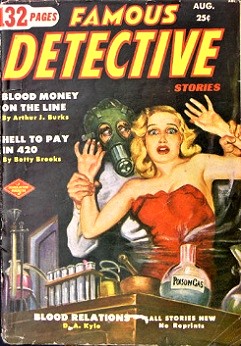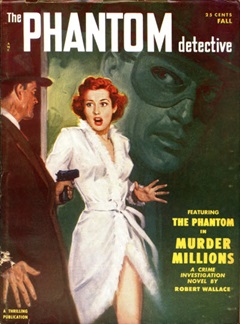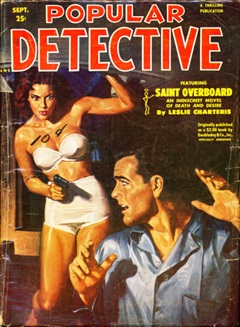
 The Whisperer (1951) aired “Woman on Ice” on September 9, 1951 as the 10th of its 13 summer replacement episodes. This is only the fourth we have showcased since the first back in October of 2022 and the first in almost a year, so a reprise of the introductory material from the previous episodes is in order for newcomers.
The Whisperer (1951) aired “Woman on Ice” on September 9, 1951 as the 10th of its 13 summer replacement episodes. This is only the fourth we have showcased since the first back in October of 2022 and the first in almost a year, so a reprise of the introductory material from the previous episodes is in order for newcomers.
The man known as the Whisperer is in reality one Philip Galt, a lawyer who was in a terrible accident in which his vocal chords were crushed. He decided to take advantage of this unusual disability as a cover to infiltrate the organized crime Syndicate in Central City, passing on to this local crime affiliate their next crime or proposed illegal  operation from the Syndicate’s national bosses in New York. Following the completion of a successful operation by Dr. Benjamin Lee and his nurse Ellen Norris that returned his voice, Galt decided to continue his undercover role as the Whisperer, setting up the local Syndicate branch and then foiling their crimes and getting them arrested, convicted, and behind bars as lawyer Philip Galt. Ellen Norris (played perfectly by Betty Moran, 1920-1998, photo at left) is now Galt’s assistant and love interest and is the only one (other than the doctor who performed Galt’s corrective surgery) who knows Galt doubles as the Whisperer.
operation from the Syndicate’s national bosses in New York. Following the completion of a successful operation by Dr. Benjamin Lee and his nurse Ellen Norris that returned his voice, Galt decided to continue his undercover role as the Whisperer, setting up the local Syndicate branch and then foiling their crimes and getting them arrested, convicted, and behind bars as lawyer Philip Galt. Ellen Norris (played perfectly by Betty Moran, 1920-1998, photo at left) is now Galt’s assistant and love interest and is the only one (other than the doctor who performed Galt’s corrective surgery) who knows Galt doubles as the Whisperer.
Philip Galt/The Whisperer was played by Carleton G. Young (1907-1971, photo top right). He appeared in a number of radio shows, had roles in a number of films, and did quite a few TV shows into the early 60s.
“Woman on Ice” begins in more or less the usual fashion, with the Whisperer having received new orders from the syndicate bosses in New York, turning to his task of delivering this new order to one of the local syndicate members in Central City. In this episode it is a simple one word message spoken to the local contact, that being “Now.” Galt/the Whisperer knows nothing more about any new operation or plan, only the word “Now” passed on to the local syndicate contact. After some trouble tracking down his unknown contact, Galt (as the Whisperer) finds the contact murdered. Unable to complete his mission and knowing the New York syndicate never takes failure as an option, Galt must scrabble for answers; answers as to who killed his contact and why, and somehow discover what plan was to be set in motion with only the urgent word “Now.” How this plays out is yet another example of the ingenuity of the script writers, for in every case Galt must play both sides while somehow maintaining his secret identity to the New York syndicate bosses, which more often than not is a tricky (and possibly deadly) game he is forced to play. And this case is no different. Galt is given an almost impossible, nearly-clueless murder mystery to solve before he can even begin to learn what the order of “Now” referred to, and then he must devise a way to thwart the plan while keeping the local authorities (including the press) from discovering his secret identity as the Whisperer while keeping the ruthless NY syndicate mob from learning he is in reality Philip Galt, the lawyer sabotaging their every illegal move. Such high-wire balancing acts and careful fence-straddling have become Galt’s stock in trade and the show’s writers deserve credit for coming up with fresh approaches to this carefully constructed premise. So without providing much in the way of detail beyond this general outline, put your deductive thinking caps on and listen now to the harrowing adventure in which Philip Galt as the Whisperer must not only preserve his secret identity (and life) but solve (and then thwart) the curious case of the “Woman on Ice.”
Play Time: 29:13
{With the new school year just under way when this episode of The Whisperer aired on a Sunday in early September of 1951, the neighborhood gang felt the need to visit a comforting friend after school the next afternoon, the nearby newsstand for some of their favorite reading, this time in the crime/detective genre much like “Woman on Ice” from the night before. Famous Detective Stories (1938-57) fit the bill nicely, and the issue below even featured a name familiar to several of the gang who had been reading the SF pulp magazines for many years—Arthur J. Burks. Like many pulp writers of the time Burks had to write for several genres just to make ends meet, and Burks was right there with the most prolific of them, knocking out stories for many magazines, a few of which were (dating from the early 1920s) Weird Tales, Astounding SF, Thrilling Wonder Stories, Horror Stories, Jungle Stories, and Dime Mystery Magazine just to name a few. Famous Detective Stories was a quarterly in 1951. The Phantom Detective (1933-53) was published in response to the success of The Shadow magazine, and while perhaps not as wildly popular as the Shadow character (who claimed a presence in film and print as well as radio), the Phantom Detective proved popular enough and sold well enough to be a welcome addition to newsstand and bookstore shelves for 20 years, holding the record for the longest running single character pulp magazine in history. It was a quarterly in 1951. Popular Detective (1934-53), while a basic meat and potatoes detective pulp, managed to maintain a consistently high level of quality with stories from many of the top authors in the field. Notice, for example in the issue below, the cover story by none other than Leslie Charteris with a new Saint story. Popular Detective was a bi-monthly in 1951.}
[Left: Famous Detective, 8/51 – Center: Phantom Detective, Fall/51 – Right: Popular Detective, 9/51]



To view the entire list of weekly Old Time Radio episodes at Tangent Online, click here.